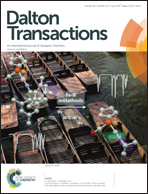Voltammetric behavior of 1- and 4-[S2VVW17O62]5− in acidified acetonitrile†
Abstract
Data derived from a voltammetric and spectroscopic study of the VV/IV couple associated with the initial reduction of the Wells–Dawson-type mono vanadium-substituted polyoxometalates, 1- and 4-[S2VVW17O62]5− in CH3CN as a function of CF3SO3H acid concentration have been obtained. 51V NMR (VV component) and EPR (VIV component) spectra were measured in CH3CN in the presence and absence of an acid. These data showed a small fraction of the 1-isomer in the 4-[S2VVW17O62]5− sample and that protonation could occur at both redox levels for both isomers. On the basis of the mechanism postulated from the voltammetric and spectroscopic data, simulations of cyclic voltammograms were undertaken for the reduction of the isomerically pure 1-[S2VVW17O62]5− isomer over a wide acid concentration range, and the results were compared with experimental data. Cyclic voltammograms of the VV/IV couple derived from the reduction of 1- and 4-[X2VVW17O62]7− (X = P, As) were also obtained in CH3CN and the results were compared with those for 1- and 4-[S2VVW17O62]5−. Reversible potentials for the VV/IV couple are dependent on the anion charge of the polyoxometalate. Analysis of cyclic voltammograms obtained for 1- and 4-[S2VVW17O62]5− in acetonitrile, acetone, dimethyl sulfoxide, dimethyl formamide and nitromethane showed that these VV/IV reversible potentials are also dependent on the acceptor numbers and the polarity index (ENT) values of the organic solvents.
![Graphical abstract: Voltammetric behavior of 1- and 4-[S2VVW17O62]5− in acidified acetonitrile](/en/Image/Get?imageInfo.ImageType=GA&imageInfo.ImageIdentifier.ManuscriptID=C5DT01530H&imageInfo.ImageIdentifier.Year=2015)

 Please wait while we load your content...
Please wait while we load your content...